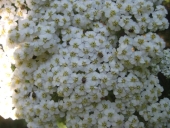I feel your pain Kelda. The property we just bought has an English walnut tree that is loaded with nuts, but infested with he walnut husk fly maggots.
At first I did not know I had a problem. I thought the nuts turned black like that when they are ready to harvest. It was only during the processing of the nuts did I discover I had a problem. As I was husking the walnuts I kept thinking to my self that something was wrong. I was thinking that it should not be this difficult to remove the husks, and why is the shell of the nut all stained. As I worked on, I started to find maggots inside the husks. I quickly went inside and did some research which pointed me to the walnut husk fly.
I also read somewhere that early frosts can worsen the problem but I can not find the link right now. The site said that early frosts will turn the husks all black and make them mushy leading to mold issues if not processed properly.
I believe this season both the fly, and early frosts affected my tree because the change from green to black seemed rather quick. That is just my opinion, and it is not backed up by any proof yet. I will observe the tree next year and see what happens.
The info provided above by my fellow Permies is great but I want to make one caution. Just because something is registered as organic doesn’t mean it can’t be harmful to us and other life forms. One must look at all the side affects of using any pesticide product, organic or not. Organic pesticides can be just as toxic and dangerous as non-organic so be careful. An example is the pesticide mentioned above ‘Spinosad’. It has been linked to harming bee foraging. See links below.
http://www.beesfordevelopment.org/info/info/pesticides/natural-pesticide-impairs.shtml http://www.organicgardeneronline.com/Organic_Pesticides.html With that said, I will be using proper IPM techniques to deal with my problem.
There are 5 main steps to IPM that I will briefly discuss
Identification: Proper id of the pest is crucial so that you can learn its biology: life cycles, behaviour, preferred habitat or host plants, etc. This helps you use treatments at the right time in the pest life cycle and can help know if the pest has natural enemies.
An example is that once I learned of the walnut husk flies life cycle I could start to deal with the problem right away. The fly feeds on the husk for 3-5 weeks and then drops to the ground to burrow into the soil to pupate. Most emerge the following year in summer to complete the cycle but some stay in for 2 years or more.
Knowing this I can use cultural methods of control to break the life cycle. Two things can be done. One is to simply remove all nuts that are one the ground on a daily basis so no maggots can get to the soil. The other is to lay a tarp under the tree during the time when the maggots are dropping, collect and destroy them or even better if they are easy to see, one might collect and feed them to his chickens. To me method two seems like it will work better because of the barrier between the soil and maggot. This will be my step one.
Monitoring: Is just regular inspections to see if the problem is getting better or worse. Records can be kept of weather conditions, beneficial species, damage, etc. Various traps can be used to help you count.
My step two will be frequent visual inspections and maybe the use of sticky or pheromone traps to aid me. I say maybe because I know that traps can harm beneficial insects too.
Action Decisions: Involves two concepts, injury level and action level. In the injury concept you set the level for what is an unacceptable amount of damage. One must remember that total eradication is most likely not achievable. The action level is when control should be applied to stop numbers reaching the injury level.
For me my injury level is when I don’t get enough walnuts from my tree to satisfy my family’s needs. I do not know what this number is yet, but I just want to be able to have some nuts and process them easily and efficiently.
Treatments: Treatments are used when preventative measures have not solved the problem. There are five general types that you can research because this post is too long.
Cultural, Physical, Mechanical, Biological, and Chemical.
My Step three will be attracting the natural enemies of the walnut husk fly by attracting them to my tree with the pollen and nectar of certain plants. This will be harder than usual because of the Juglone secreted by the walnut roots. Some homework needs to be done here. If I have to I will even order in some bugs and let them loose. I will also have many bird houses and
bat houses with hopes that this might help. I will not use chemicals to remedy the problem and I will even go as far as removing the tree if I can not fix the problem. The wood will be put to good use and I could plant other trees there. I would be loosing a beautiful tree that provides a nice shady spot.
Evaluation: Is simply determining what worked and what didn’t and creating ways to improve the program.
I know this was a long post but I hope it helps someone out.
Cheers and good luck with your walnut tree Kelda.
Colin









 thats all I found.
thats all I found.











 2
2








